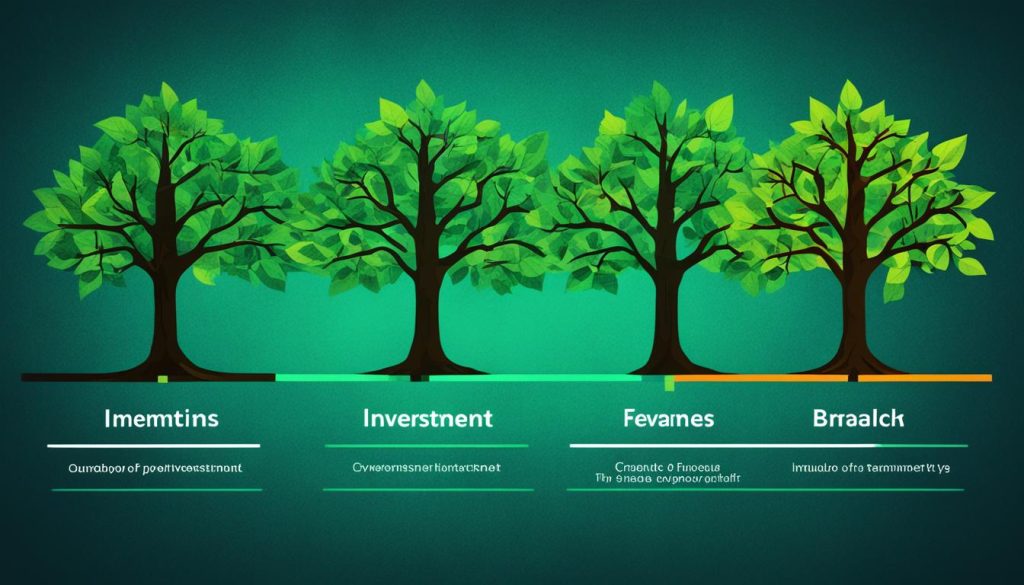Investing can seem overwhelming with so many options. But, it’s good to know that investments mainly fall into three groups: equity, fixed-income, and cash or cash equivalents1.
Equity investments, like stocks, give you a part of a company’s ownership. If the company does well and grows, your shares could increase in value. This could lead to making money from your investment1.
Fixed-income investments, such as bonds, are when you lend money to a government or company. They pay you back with regular interest. These investments usually offer a steady return, unlike equity investments2.
Cash and cash equivalents, like checking and savings accounts, are also investments. They focus on keeping your money safe and offer a small return2.
Knowing about these investment types and how they fit in your portfolio is key. It helps match your investments with your financial goals and how much risk you can handle.
Key Takeaways
- Investments can be categorized into three main types: equity, fixed-income, and cash or cash equivalents.
- Equity investments, like stocks, provide ownership in a company and the potential for capital gains.
- Fixed-income investments, such as bonds, offer regular interest payments and more predictable returns.
- Cash and cash equivalents aim to preserve capital and provide stable, but lower, rates of return.
- Understanding investment types is crucial for aligning your portfolio with your financial goals and risk tolerance.
Introduction to Investing
What is Investing?
Investing means putting money into something with the hope of making more money. This can come from income, profit, or gains. It’s different from speculation, which looks for quick price changes. Investors usually look at a longer time frame, like months or years, for good returns.
Risk and return go hand in hand in investing. Lower-risk investments usually give lower returns. But, higher-risk investments could bring in more money.
The S&P 500 Index has made about 10 percent a year on average3. Small-cap stocks have grown by around 12 percent yearly over time3. Recently, big companies like Nvidia, Microsoft, and Apple have done better than small ones3.
Treasury bills are short-term, lasting three months. Treasury notes and bonds take a year or more to mature3. U.S. government bonds are very safe because the government backs them3. Municipal bonds offer tax-free income from federal and sometimes state taxes3.
Mutual funds make it easy to spread out your investments across different assets3. Index funds follow indexes like the S&P 500 and are cheaper and more efficient than some other funds3. They’re great for those who want to diversify and save time on investment tracking3.
Putting money into various assets like stocks, bonds, and mutual funds can help control risk and boost returns over time. Knowing about the different investments can help you make smart choices for your financial goals.
“Investing should be more like watching paint dry or watching grass grow. If you want excitement, take $800 and go to Las Vegas.” – Paul Samuelson
investment types, stocks, bonds, mutual funds
The world of investing offers many types of assets, each with its own risk and reward. Stocks, or equities, let you own parts of companies. They can offer big returns but also come with more risk45.
Bonds are debt tools where investors lend money to governments or companies for fixed returns. They are seen as safer than stocks, with less risk of losing money45.
Mutual funds pool money from many investors to buy different securities. They offer professional management and spread out investments. This way, investors can easily get into many types of assets with one investment45.
| Investment Type | Potential Returns | Risk Level |
|---|---|---|
| Stocks | High | High |
| Bonds | Moderate | Low |
| Mutual Funds | Varies | Varies |
Building a diverse portfolio often means mixing stocks, bonds, and mutual funds. This depends on your financial goals, how much risk you can handle, and when you plan to invest4. Your age, income, and investment time frame are key in making these choices4. You can pick from mutual funds, ETFs, or individual stocks to fit your investment plan45.

“Diversification is the only free lunch in investing.” – Harry Markowitz, Nobel Laureate in Economics
Knowing about the risks and rewards of these main investment types helps investors make smart choices. This way, they can create a diverse portfolio to meet their financial goals.
Equity Investments
Stocks and Shares
Stocks let you own a part of companies that are traded on the market. When you buy stock, you become a part-owner. You can see your investment grow through higher prices and dividends6. These securities give you a claim on a company’s profits and assets6.
Stocks are riskier than bonds because their value can change a lot. This depends on the market and how well the company does6. But, they can also offer big returns over time7. Stocks have given the best long-term returns7.
Investing in different types of assets like stocks, bonds, commodities, and real estate helps diversify your portfolio7. Each type of asset has its own risk and reward levels. This mix helps create a strong investment plan7.
| Asset Class | Characteristics | Examples |
|---|---|---|
| Equities (Stocks) | Represent ownership in a corporation, potential for capital appreciation and dividends | Common stocks, preferred stocks |
| Fixed Income (Bonds) | Provide regular interest payments, subject to price and credit risks | Government bonds, corporate bonds, municipal bonds |
| Cash Equivalents | Highly liquid assets, low-risk, provide stable returns | Money market instruments, savings accounts, CDs |
It’s key to know the risks and rewards of any investment before deciding. This helps you see if it fits your goals8. Even with diversification, you can still lose money if the market goes down8.
“Investing in stocks is a way to build wealth over the long term, but it’s important to understand the risks involved and diversify your portfolio accordingly.”
Fixed-Income Securities
Investing in fixed-income securities, like bonds, is a unique chance. These debt tools let investors lend money to governments or companies. In return, they get regular interest payments9. Bonds usually don’t offer as much return as stocks but are seen as safer. This is because investors get their money back when the bond ends9. But, there’s still a risk that the borrower might not pay back the debt9.
Government bonds, like U.S. Treasury bonds, are seen as the safest type of fixed-income investment. Corporate bonds, however, carry more risk but might offer higher returns9. Investors can choose from a variety of fixed-income securities, from short-term Treasury bills to long-term bonds and high-yield “junk” bonds9. These investments can provide a steady income and help balance the risk and return of an investment portfolio9.
Investors have many ways to buy fixed-income securities. Schwab offers access to thousands of bonds from many dealers10. Over a thousand new bond issues come out each year10. Investors can also look into fixed-income managed accounts, like those from Wasmer Schroeder Strategies, which start at $250,00010. Or, they can consider CDs and bond mutual funds, which might have lower investment minimums10.
| Fixed-Income Investment | Description | Risk Level |
|---|---|---|
| U.S. Treasury Bonds | Debt securities issued by the U.S. government, considered the safest fixed-income investments | Low |
| Corporate Bonds | Debt securities issued by corporations, carry more risk than government bonds but potentially higher returns | Medium |
| High-Yield “Junk” Bonds | Bonds issued by companies with lower credit ratings, pay higher coupons due to higher default risk | High |
Whether you’re experienced or new to investing, knowing about fixed-income securities is key. It helps in building a diverse investment portfolio. By looking at the different options and their risks, you can make choices that fit your investment goals and how much risk you can handle.

“Fixed-income investments offer a steady stream of income over the life of the security and help stabilize the risk-return profile of an investment portfolio.”
Pooled Investment Vehicles – Mutual Funds and ETFs
Mutual funds and exchange-traded funds (ETFs) are great for building a diverse investment portfolio. They let you invest in many securities with the help of professional money managers. This way, you get the benefits of diversification11.
Mutual funds are actively managed by fund managers who pick the investments for you. ETFs, on the other hand, track a specific market index. This means you can easily follow the performance of a whole index or sector. Both options invest in various assets like stocks, bonds, and commodities. They’re a smart choice for investors who want a simple and diverse way to get into the market11.
These investment tools offer lower risks thanks to diversification. They also give you the advantage of buying power and professional management11. Over the years, the mutual fund industry has grown a lot. In 1980, less than 6% of U.S. households invested in mutual funds. By 2023, that number jumped to about 52%12.
Today, American households hold 88% of all mutual fund assets. This shows how important individual investors are in this market12.
FAQ
What are the main types of investments?
Investing can seem overwhelming with so many options. But, you can group investments into three main types: equity, fixed-income, and cash or cash equivalents. Equity investments let you own parts of companies. Fixed-income investments let you lend money for interest. Cash and cash equivalents, like checking accounts, are also investments.
What is the difference between investing and speculation?
Investing means putting money into something with the hope of making a profit over time. It’s different from speculation, which focuses on short-term price changes. Investors look at a longer time frame, like months or years, for returns.
What are the major investment types?
There are many types of investments, each with its own risk and potential return. Stocks let you own parts of companies. Bonds are when you lend money for interest. Mutual funds pool money to invest in various securities, giving you a broad investment mix.
What are the key characteristics of stocks?
Stocks let you own parts of companies. Buying stocks means you can share in the company’s growth and profits through price changes and dividends. Stocks can be riskier than bonds but may offer higher returns over time.
What are the key characteristics of fixed-income securities?
Fixed-income securities, like bonds, are when you lend money to governments or companies for interest. They usually offer lower returns but are seen as safer, as you get your money back at maturity. But, there’s still a risk of the borrower not paying back the debt.
What are the benefits of mutual funds and ETFs?
Mutual funds and ETFs let investors put money into a mix of securities. Mutual funds are actively managed by professionals. ETFs track specific indexes but are traded like stocks. Both offer diversification and professional management, with ETFs also being traded on stock exchanges.
Source Links
- Investing Explained: Types of Investments and How to Get Started
- Investing for Beginners: A Guide to Assets
- Stocks, Bonds And Mutual Funds: Key Differences | Bankrate
- Stocks, Bonds, and Mutual Funds
- 6 Types of Investments to Know About – NerdWallet
- What Are Different Types of Investment Securities?
- What Are Asset Classes? More Than Just Stocks and Bonds
- Different Types of Basic Investments: What to Know
- Guide to Fixed Income: Types and How to Invest
- Fixed Income Investments | Charles Schwab
- Pooled Funds: Definition, Examples, Pros & Cons
- What Are Mutual Funds?

